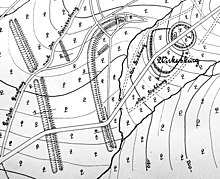Wirkesburg
| Wirkesburg | ||
|---|---|---|
|
Wall of the Wirkesburg in the sloping terrain with remains of stone |
||
| Alternative name (s): | Witte castle | |
| Creation time : | around 900 to 1000 | |
| Castle type : | Hillside castle | |
| Conservation status: | Burgstall | |
| Place: | Lauenau -Feggendorf | |
| Geographical location | 52 ° 17 '24 .1 " N , 9 ° 24' 14.1" E | |
|
|
||
The Wirkesburg , also called Witte Burg , was a small early medieval ring wall , the remains of which are on the west side of the Deister near the Lauenau district of Feggendorf in Lower Saxony . The hill fort on the hillside probably served the population as a refuge , but could also have served as a fortified aristocratic seat. The period of origin and use of the complex, which has not yet been archaeologically examined, is classified in the 10th to 12th centuries.
location
The former fortification is located in a forest on the western slope of the Deister , about 500 m east of the outskirts of Feggendorf. It is only about 600 m south of the Heisterburg , a much larger rampart of a similar construction. The Wirkesburg was built on a sloping ridge. Streams provided natural protection on two sides. In the 19th century, the ramparts were cut in the middle by a forest road and a railway line. The railway line that was no longer in existence led to the Feggendorfer Stollen coal mine located above, now disused (now a visitor mine ). Laterally old perform at the Wallburg ravines up to the Deister ridge.
description
Today only earth walls are left of the fortification. There are many limestone stones that are typical of the region and which apparently once belonged to the wall. In about two meters high Wallaufschüttungen of main and Vorburg are remnants of a mortar wall exist. This speaks in favor of a stone wall that was once several meters high and was in front of the ramparts. This type of construction, partly using tree trunks, can be found in similarly designed systems from the same period in the vicinity.
The core of the Wirkesburg is a ring wall around 50 m in diameter, which covers an area of around 0.2 ha. On the slope below there is a 4 hectare outer bailey. Both fortifications were surrounded by a moat .
There are two mighty ramparts below the complex. They are better preserved than the ramparts of the main works. The first rampart is three meters high, and the trench in front of it is about two meters deep. The second, 300 m long rampart is 4 m high and has a four meter deep trench. In addition, there are two small moat pieces on the side of the ramparts.
Use and development interpretation

Due to the way it was built, it is assumed that the complex was built and used in the 10th to 12th centuries. An archaeological investigation has not yet taken place. In 1904 the archaeologist Carl Schuchhardt only carried out a superficial exploration, which did not reveal any findings.
According to one theory, representatives of the Billunger or Welfs , who had lived in the Lauenau area since the 11th century, could be considered as the builders of the facility . Because of its size and structure, only a refugee castle is possible as a function of the ramparts . In times of danger, the local population could seek refuge here with their cattle.
Similar fortifications in the vicinity
- In the plane:
- Isenburg near Barsinghausen -Landringhausen
- Düsselburg near Rehburg
- Lüningsburg near Neustadt am Rübenberge
- In height:
- Heisterburg near Lauenau -Feggendorf
- Barenburg near Eldagsen
- Heisterschlösschen near Beckedorf
- Kukesburg near Springe -Altenhagen
- Bennigser Castle near Bredenbeck- Steinkrug
- Sachsenwall near Nordstemmen
Fortifications of this kind were originally regarded as Saxon or Heinrichsburgen by archaeological research . The more recent research assigns the structures in the area of the Central Weser and the Leine to a period from 8th to 12th centuries. Century too. Due to the lack of settlement, the facilities are likely to have only been used sporadically and have served as refuges. In the case of the facilities in the Deister area (Wirkesburg, Bennigser Burg, Heisterschlösschen) it is typical that they were built on sloping mountain ridges and near a stream.
literature
- Hans-Wilhelm Heine : The Wirkesburg near Feggendorf . In: Guide to Prehistoric and Protohistoric Monuments. Volume 49. Part II Excursions . Mainz 1981
- Hans-Wilhelm Heine: The prehistoric and early historical castle walls in the administrative district of Hanover . Hannover 2000, ISBN 3-7752-5645-8 , pp. 152-153.
- Hans-Wilhelm Heine: Schaumburger Land - Burgenland , in the series Guide to the Prehistory and Early History of Lower Saxony (29), Oldenburg 2010, published by the Lower Saxony State Office for Monument Preservation and the Archaeological Commission for Lower Saxony , ISBN 978-3-89995-673-3
Web links
- Entry by Stefan Eismann about Wirkesburg in the scientific database " EBIDAT " of the European Castle Institute
- Wirkesburg at www.burgenwelt.de
- Site plan of the facility ( Memento from April 28, 2010 in the Internet Archive )
- Wirkesburg in: Castles around 1000 between Mittelweser and Leine ( Memento from February 4, 2004 in the Internet Archive ) (PDF, 500 kB)

